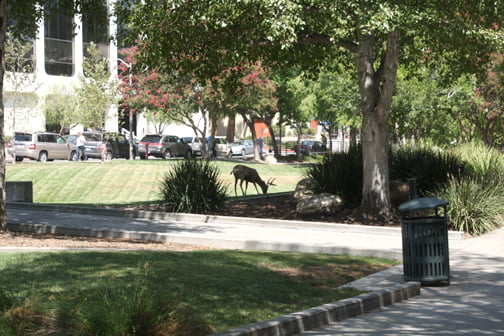NASA administrator Charles Bolden toured JPL clean room in anticipation of the year of Earth science.

Wendy Edelstein, SMAP instrument manager, explains her portion of the JPL project to administrator Bolden.
By Mary O’KEEFE and Molly SHELTON
On Monday, NASA administrator Charles Bolden visited Jet Propulsion Laboratory to see the progress of the Soil Moisture Active Passive (SMAP) mission that will be launched in 2014.
“It’s the year of Earth science,” Bolden said.
SMAP is a satellite that will survey the surface of the Earth to produce global maps of soil moisture for tracking water availability and measure carbon dioxide levels around the planet.
This project, Bolden said, will capture the attention of larger audiences than the normal work of JPL.
“When you think of JPL, you think space. This project will help bring NASA back to Earth and show that we focus on more than just the extraterrestrial,” he said.
Bolden toured the JPL “clean room” with NASA JPL director Charles Elachi, deputy director of Earth Science and Technology Division at JPL Jim Graf and director of the Earth Science Division, Science Mission Directorate at NASA Mike Freilich.
The clean room is the spacecraft assembly room where the final preparations are made before launch. Those who enter the room first walk over a sticky mat to remove particles off the bottom of shoes, then must don what JPL calls a “bunny suit” (a long gown much like a hospital gown), put on latex gloves, a hair net and then walk through a type of mini wind tunnel before entering the room. This is all in an attempt to keep earthly particles on Earth and not contaminate the spacecraft – or space.
Bolden has visited the lab several times but this occasion was especially rewarding for local resident Wendy Edelstein, instrument manager for the SMAP project.
Edelstein works with the different agencies that are building the various components of the spacecraft. She deals not only with the engineering side of projects but the business side as she works with companies like Northup Grumman, Astro Aerospace and NASA’s Goddard Space Flight Center to make certain everything comes together as planned.
She is celebrating 25 years at JPL and loves what she does.
“Well, I loved math when I was a kid,” she said as to why she pursued a career as an engineer. “When I went to high school, I really loved math and my parents encouraged me and said engineering is something good to go into.”
During college she worked as a radio frequency engineer intern and loved the work.
In the late 1980s she had a choice to make as an engineer – she could work in the area of defense or do something that could help the planet through Earth science. She chose Earth science.
“I am doing something that benefits our society,” she said. “[I’m] doing something fun and important.”
She has advice for young girls who are interested in science or math.
“I have a daughter; she works really hard,” Edelstein said. “That is what I would [say] – work really hard and don’t give up. Girls can do just as well as boys.”
Edelstein had an opportunity to show the radar and radiometer instruments to Bolden. In fact, each engineer had a chance to share their piece of the spacecraft puzzle with the administrator.
The reason this was important to many interviewed was the project was Earth, not space, exploration that was being highlighted. JPL is well known for its successful missions to planets like Mars and Saturn, but the lab also works on Earth science.
SMAP will supply data in many areas in addition to mapping soil moisture for tracking water availability around the planet. The project will help detect winter freeze and spring thaw to determine the length of growing seasons.
SMAP will be able to see where cyclones begin, which will give a more accurate prediction of when a storm will hit the shore and the strength of it.
For more information on SMAP, visit www.jpl.nasa.gov and search for SMAP.


















